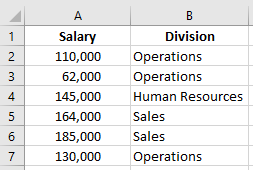Functions¶
A fundamental part of R programming is the use of functions, which are very similar to functions in Excel. For example, you may be familiar with the Excel function SUMIF(), which sums the values in a range of cells that adhere to a certain criteria. Let’s return to the small data set from Fig. 3:

Fig. 3 Example Excel Worksheet¶
Imagine that we wanted to calculate the total amount spent on only those employees in the Operations department. We can accomplish this with SUMIF(), which uses the following syntax:
Syntax
SUMIF(range, criteria, sum_range)
Required arguments
range: The range of cells where the criteria should be evaluated.criteria: The criteria to apply to the cells inrange.
Optional arguments
sum_range: The cells to sum based on the criteria.
To apply this function to the data shown in the figure, we would write =SUMIF(B2:B7, "Operations", A2:A7), which would evaluate to 302,000. Feel free to verify this in Excel yourself.
Note that every time we use the SUMIF() function, we must specify the range and criteria arguments. The sum_range argument is optional, and we only need to use it if we want to sum a different set of cells than those specified in the range argument.
Whenever we introduce a new R function, we will follow the same convention shown above to demonstrate the syntax of the function. The basic syntax of the function will be shown in a light blue box marked “Syntax”, and any required and optional arguments will be described within the box. Additionally, whenever you are learning a new function, we encourage you to search Google for examples, as well as review the official documentation for the function at rdocumentation.org.
Tip
You can look up the syntax for a function on rdocumentation.org, and/or search Google for helpful examples.
Now let’s learn an actual R function. One commonly used function is length(), which (as you might guess) determines the length of an R object. This function uses the following syntax:
Syntax
length(x)
Required arguments
x: An R object.
We can apply this function to the atomic vectors we created in the previous section to determine how many values each one contains:
length(v4)
[1] 4
length(v5)
[1] 3
length(v6)
[1] 2
length(v7)
[1] 4
Additionally, there is a sum() function we can use to add up all the values of an atomic vector. This function uses the following syntax:
Syntax
sum(x, na.rm=FALSE)
Required arguments
x: An R object.
Optional arguments
na.rm: IfTRUE, the function will remove any missing values (NAs) in the atomic vector and sum the non-missing values. IfFALSE, the function does not removeNAs and will return a value ofNAif there is anNAin the atomic vector.
Note that this will not work for v6, because there is no logical way to sum characters together. If we apply it to v5, it will treat the TRUE values like 1 and the FALSE values like 0.
sum(v4)
[1] 14
sum(v5)
[1] 2
sum(v7)
[1] NA
What happened with v7? Recall that this vector contains a missing value (NA). If you review the syntax for the sum() function, you’ll see that it includes an optional parameter na.rm, which determines how the function treats missing values. If this argument is set to TRUE, it ignores missing values and calculates the sum of the non-missing values. If it is set to FALSE, the function will return NA if there is a single missing value present.
However, in our call to the sum() function, we didn’t include this argument at all, so what is going on? Optional arguments often have a default value that is used if you fail to specify the desired value explicitly. In this case, the default value is FALSE, so if we do not specify na.rm=TRUE in our call to sum(), the missing values will not be ignored and the function will return NA.
If we re-run the function but add na.rm = TRUE, we get the expected result:
sum(v7, na.rm = TRUE)
[1] 27
Similar to sum(), there are many other functions that can be applied to atomic vectors:
Syntax
mean(x, na.rm=FALSE)
Required arguments
x: An R object.
Optional arguments
na.rm: IfTRUE, the function will ignore any missing values (NAs) in the atomic vector. IfFALSE, the function does not ignoreNAs and will return a value ofNAif there is anNAin the atomic vector.
Syntax
min(x, na.rm=FALSE) & max(x, na.rm=FALSE)
Required arguments
x: An R object.
Optional arguments
na.rm: IfTRUE, the function will ignore any missing values (NAs) in the atomic vector. IfFALSE, the function does not ignoreNAs and will return a value ofNAif there is anNAin the atomic vector.
mean(v4)
[1] 3.5
min(v5)
max(v5)
[1] 0
[1] 1
mean(v7, na.rm = TRUE)
[1] 9
Before moving on to the next section, work through the two exercises below.
